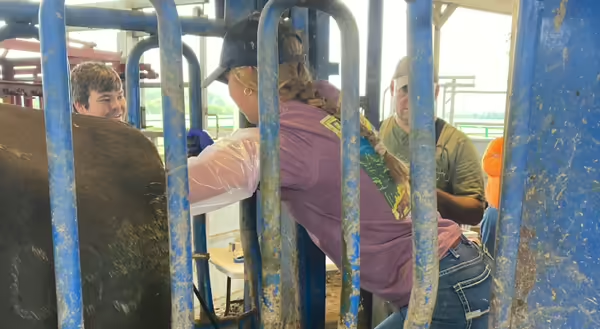
Pregnancy checking cattle is beneficial to any operation. Culling open animals allows for saved feed costs and potential profit. Keeping a tight calving window increases the importance of pregnancy checking. When checking, if cattle are bred and don’t fit your desired calving season, they can typically be marketed at a higher price. If cows or heifers are identified as open in a timely fashion, producers then have time to grow and market those animals. History has shown that cull cow prices can be 5-10% higher in August compared to October and November. Timely pregnancy checking provides cattleman with valuable information about their herd.
Importance
Pregnancy checking gives producers the information needed to prepare for calving season. By identifying open females/cull cows, you can reduce feed costs by feeding a more cost-effective diet. Evaluating the body condition score of cows as you check them also influences nutritional management. If cows are thin in the fall, there is still time to put weight on them before spring calving and vice versa with heavier cows. When it comes to keeping your operation profitable and efficient, pregnancy checking is crucial. Determining conception rate assists in planning for vaccinations, facilities, and labor needed. If selling bred females and calving date or AI pregnancies are identified, farmers are better able to strategically market cattle. Keep in mind, pregnancy detection can happen 30 days after bulls are removed or AI date.
Palpation
Palpation is the most invasive method of pregnancy checking. This can lead to an increased risk of loss in early pregnancy. With manual palpation results are known immediately. Open cows and pregnant cows can be sorted more conveniently off the chute. Palpation can be performed by an experienced veterinarian and can be detected as early as 35-50 days gestation.
Ultrasound
Like palpation, ultrasound allows immediate results. Pregnancy can be identified at 28 days gestation and it is less invasive than manual palpation. This method can allow operators to ID the calf’s age. Sex can be also identified during the primary window of 55-70 days post-breeding. Twins can be identified early which can allow for advanced preparation. Ultrasound usually requires additional equipment and experienced operators. If your operation utilizes AI and cleanup bulls, knowing the calf’s age can help determine what the parentage is.
Blood Test
This method of pregnancy checking is the least invasive of the three and typically the least expensive. The blood test can ID pregnancy as early as 30 days gestation, however, it offers little information beyond a simple positive or negative. Results are not known immediately and there is often a 2-4 day turn around period. This type of test often can’t determine the stage of the pregnancy. If wanting more than one test, samples can be pulled and sent to the lab over the course of several days. Cows should be at least 90 days post calving before pulling blood, or there is an increased risk of a false positive.
Summary
Using palpation, ultrasound, and blood testing are all common ways to pregnancy check your herd. Factors like economics and the availability of resources all influence what method of pregnancy checking is used. Some producers utilize a combination of the three, or different methods for cows and heifers. Utilizing pregnancy checking gives producers the ability to better organize calving groups and to make informed management decisions.
About the Author
Mabry Bruhn is a student at the University of Illinois Urbana-Champaign who works in beef production, research, and producer outreach as a University of Illinois Extension intern in the I-BELIEF program through the Department of Animal Sciences in the College of Agricultural, Consumer and Environmental Sciences. This article has been reviewed by Extension Commercial Agriculture Educator, Travis Meteer.